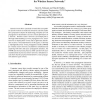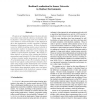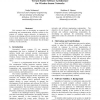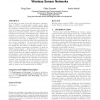ICDCSW
2005
IEEE
14 years 5 months ago
2005
IEEE
Internet worms have repeatedly revealed the susceptibility of network hosts to malicious intrusions. Recent studies have proposed to employ the underlying principles of worm propa...
ICDCS
2005
IEEE
14 years 5 months ago
2005
IEEE
The process of computing the physical locations of nodes in a wireless sensor network is known as localization. Selflocalization is critical for large-scale sensor networks becaus...
ICDCS
2005
IEEE
14 years 5 months ago
2005
IEEE
Wireless sensor networks (WSNs) are difficult to program and usually run statically-installed software limiting its flexibility. To address this, we developed Agilla, a new midd...
COMPSAC
2005
IEEE
14 years 5 months ago
2005
IEEE
This research aims at developing an approach for architecting and communicating software systems in the context of wireless sensor networks. In particular, it focuses on developin...
COLCOM
2005
IEEE
14 years 5 months ago
2005
IEEE
When two sponsoring organizations, working towards separate goals, can employ wireless sensor networks for a finite period of time, it can be efficiency-enhancing for the sponso...
CEC
2005
IEEE
14 years 5 months ago
2005
IEEE
With the emergence of wireless sensor networks and pervasive computing, innovative location-aware technologies and services are being investigated. Several iterative approaches emp...
AICCSA
2005
IEEE
14 years 5 months ago
2005
IEEE
Recent years have witnessed a growing interest in the application of wireless sensor networks in unattended environments. Nodes in such applications are equipped with limited ener...
SIGCSE
2006
ACM
14 years 5 months ago
2006
ACM
Target tracking is one of the most important applications of wireless sensor networks. Optimized computation and energy dissipation are critical requirements to maximize the lifet...
SASN
2006
ACM
14 years 5 months ago
2006
ACM
Intrusion or misbehaviour detection systems are an important and widely accepted security tool in computer and wireless sensor networks. Their aim is to detect misbehaving or faul...
PEWASUN
2006
ACM
14 years 5 months ago
2006
ACM
In this paper, we study end-to-end performance characteristics of S-MAC, an energy-aware medium access control (MAC) protocol for wireless sensor networks (WSN). WSNs are composed...




